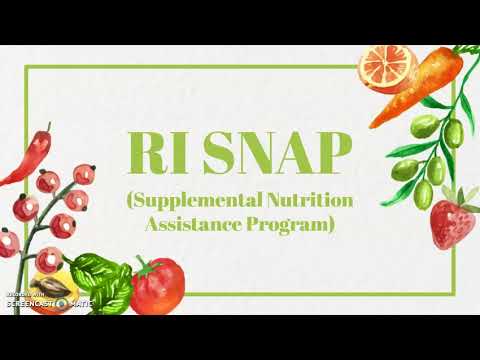Introduction to the Supplemental Nutrition Assistance Program (SNAP)
The Supplemental Nutrition Assistance Program (SNAP), formerly known as Food Stamps, is a federal assistance program in the United States that provides nutrition benefits to eligible low-income individuals and families. In Rhode Island, the program is administered by the Department of Human Services (DHS). SNAP benefits are provided in the form of an Electronic Benefit Transfer (EBT) card, which can be used to purchase food items at authorized retailers, including grocery stores and farmers markets.
Eligibility requirements for the SNAP program in Rhode Island
To be eligible for the SNAP program in Rhode Island, individuals and families must meet certain income and resource limits. Income eligibility is based on the household’s gross monthly income, which includes wages, self-employment income, and government benefits. The income limits vary depending on the household size, but generally, households with gross incomes at or below 130% of the federal poverty level are eligible for SNAP benefits. Additionally, applicants must also be U.S. citizens or qualified non-citizens and reside in Rhode Island.
Step 1: Gathering necessary documents for SNAP application
Before applying for SNAP benefits in Rhode Island, it is important to gather all the necessary documents to support your application. These may include proof of identity, such as a driver’s license or state ID card, social security numbers for all household members, proof of residency, such as utility bills or lease agreements, and proof of income, such as pay stubs or benefit award letters. It is crucial to have all the required documentation ready to ensure a smooth application process.
Step 2: Fill out the SNAP application form accurately
The next step in applying for SNAP benefits is filling out the application form accurately. The application can be found online on the Rhode Island DHS website or can be obtained in person at a DHS office. It is important to provide complete and accurate information, including details about household composition, income, expenses, and resources. Any false information provided may result in denial of benefits or potential legal consequences, so it is essential to be thorough and honest while completing the application.
Step 3: Submitting your SNAP application in Rhode Island
Once the application form is completed, it can be submitted to the Rhode Island DHS. Applications can be submitted online through the DHS website, mailed to the DHS office, or dropped off in person at a DHS office. It is advisable to keep a copy of the application for your records and ensure that it is submitted within the required timeframe.
Step 4: Scheduling an interview with the SNAP program
After submitting the SNAP application, applicants will be contacted by a DHS representative to schedule an interview. The interview is a crucial step in the application process as it allows the DHS to verify the information provided and gather any additional details necessary for determining eligibility. The interview can be conducted in person, over the phone, or through a video call, depending on the applicant’s preference and circumstances.
Step 5: Providing verification documents for your SNAP application
During the interview, applicants will be required to provide supporting documents to verify the information provided on the application form. These may include proof of income, expenses, residency, and other relevant documentation. It is essential to have these documents readily available and to bring them to the interview or submit them as requested. Failure to provide the necessary verification documents may lead to delays in the application process or denial of benefits.
Step 6: Reviewing and confirming your SNAP eligibility
Once the interview and verification process is complete, the DHS will review the application and supporting documents to determine eligibility. This process typically takes around 30 days from the date of application submission. If approved, the applicant will receive a notice of eligibility and the amount of SNAP benefits they qualify for. If denied, the applicant will receive a notice explaining the reasons for denial and the right to appeal the decision.
Step 7: Receiving your SNAP benefits card in Rhode Island
If deemed eligible for SNAP benefits, the applicant will receive their Electronic Benefit Transfer (EBT) card in the mail. The EBT card works like a debit card and is loaded with the approved monthly benefit amount. It can be used at authorized retailers to purchase eligible food items. The card should be kept in a safe place and the PIN number should be memorized to protect against unauthorized use.
Step 8: Understanding the SNAP benefit calculation process
The amount of SNAP benefits an individual or household receives is determined by the SNAP benefit calculation process. This calculation takes into account various factors, including household size, income, expenses, and deductions. The SNAP benefit amount is designed to supplement the household’s monthly food budget and is adjusted annually based on changes in the cost of living.
Step 9: Using your SNAP benefits wisely and effectively
To make the most out of SNAP benefits, it is important to use them wisely and effectively. This includes planning meals, comparing prices, and making nutritious food choices. SNAP benefits can be used to purchase a variety of food items, including fresh produce, grains, dairy products, meat, and non-alcoholic beverages. It is advisable to create a budget and stick to it, so the benefits last throughout the month.
Step 10: Reporting changes in circumstances to the SNAP program
It is crucial to report any changes in circumstances to the SNAP program in Rhode Island. Changes such as income fluctuations, household composition, address, or employment status can impact eligibility and benefit amounts. Failure to report changes in a timely manner may result in overpayment of benefits, which will need to be repaid, or underpayment of benefits, which may cause a temporary loss of assistance. It is the responsibility of SNAP recipients to inform the DHS promptly of any changes to ensure accurate benefit calculations and program compliance.
By following these steps, individuals and families in Rhode Island can apply for and receive the supplemental nutrition assistance they need through the SNAP program. The program aims to alleviate food insecurity and improve the overall well-being of eligible individuals and households.





